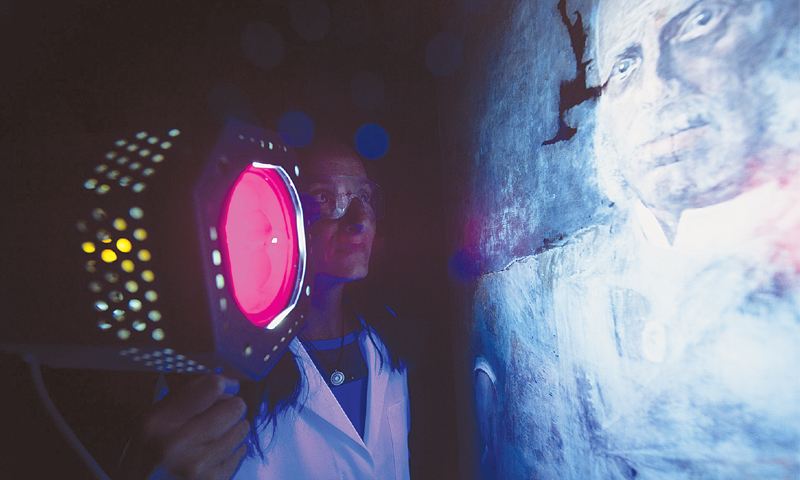GENEVA: Dressed in an immaculate white lab coat, Sandra Mottaz stares intently through a stereo microscope at a bold-coloured painting purportedly by French master Fernand Leger, searching for signs of forgery.
“Here, we can make out vertical lines in what could be a grid,” Mottaz says, looking up from the shiny white instrument providing a three-dimensional view of the painting.
That could signal the painting is a fake, but artists themselves also use the technique to copy their own work onto different formats, so more tests are needed, she says.
Mottaz and her colleagues at the Fine Arts Expert Institute (FAEI) use cutting-edge scientific methods like radiocarbon dating and infrared reflectography to determine the authenticity of artworks, and sometimes to uncover unknown masterpieces.
“When you buy an apartment, you always get an appraisal first. But in the art world, until recently, you could buy works for 10 million euros without sufficient documentation,” says FAEI chief Yann Walther.
But that is changing amid soaring prices in an art market where works worth an estimated $60 billion change hands each year.
The ballooning amounts up for grabs have also hiked the incentive for art forgers, and scientists like Walther and Mottaz are increasingly being called upon to supplement efforts by traditional art experts and conservationists to authenticate works.
Half artwork in circulation fake
The art world has in recent years been rocked by forgery scandals, revealing fake works attributed to a long line of masters, including Paul Gauguin, Marc Chagall, Jackson Pollock and Leger.
Experts estimate a full half of all artworks in circulation today are fake — a number that is difficult to verify but that Walther says is, if anything, an underestimate.
Between 70 and 90 per cent of works that pass through FAEI turn out to be fake, he says.
His institute sits inside the Geneva Freeports, a heavily-guarded toll- and customs-free zone where collectors from around the world store more than a million artworks, including Picassos, Van Goghs, Monets and apparently a Leonardo da Vinci.
It can be tricky spotting fakes with the naked eye, but top-notch lab equipment helps.
Mottaz carefully carries the Leger to another room where her colleague Valeria Ciocan uses infrared reflectography to confirm the grid underneath the working man’s face, supposedly painted in 1954.
Lab chief Kilian Anheuser then moves the piece to the nearby x-ray room, where he determines that the pigments used are different from the ones Leger usually turned to in the 1950s.
This is still not hard proof of a forgery, says Anheuser, who wants to go on to radiocarbon date the paper, allowing him to determine if it is from trees felled before or after nuclear tests carried out in the 1950s.
If the paper can be dated to after 1955, when Leger died, the answer will be obvious, he says, adding though that he needs the go-ahead from the owner before moving forward with pricier tests.
Depending on what tests they run, scientific labs can charge clients up to 15,000 euros ($19,000) per painting, which might sound steep until you consider the value of many of the paintings they study.
Analysis adds value
Another piece provides a starker example of what can be found lurking under the surface of paintings that look fine at first glance.
A reclining nude attributed to French artist Albert Marquet and dated 1912 looks authentic until Ciocan uses reflectography to expose a tractor painted in great detail underneath.
The tractor’s tyres, revealingly, are of a make that did not hit the market until the 1930s.
The research sometimes also reveals that a work is of greater value than first thought.
Walther recalls one of the first pieces to pass through the lab: a painting titled ‘Winter Scene’ by 17th century Dutch great Adam Van Breen.
The piece, owned by a Geneva collector, was believed to be a copy the artist or his atelier had made of what was thought to be the original, which hangs in the Louvre in Paris.
But the scientists found sketching underneath indicating the artist’s own research, hinting that the Geneva collector’s piece was in fact the original.
Even without such startling findings, “scientific analysis adds value to artworks”, Walther says, pointing out that his institute’s research helps “tell a story”, revealing the artist’s creative process and the techniques used.
Art historian and restorer Andrea Hoffmann of Atelier Arte in Geneva agrees that scientific methods can be useful in some cases.
But these methods are no substitute for traditional experts like herself, who draw on familiarity with an artist’s style and historical context to spot problems.
“Ninety per cent of what can be seen in a painting can be seen with your eyes,” she says, stressing: “That is where experience comes in.”—AFP
Published in Dawn, October 9th, 2014














































Dear visitor, the comments section is undergoing an overhaul and will return soon.